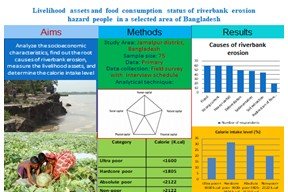Livelihood assets and food consumption status of riverbank erosion hazard people in a selected area of Bangladesh
Abstract
Riverbank erosion is a major threat to Bangladesh refers to an endemic and recurrent natural hazard of our country. The study was conducted to identify the socioeconomic characteristics, find out the root causes of riverbank erosion, determine the livelihood assets and measure the calorie intake level of the riverine people. Primary data were collected from Jamalpur district in Bangladesh. The DFID approaches of livelihood and the consumption data of riverine households of seven days was measured by per person per day calorie intake level. The findings revealed that 72% of the respondents belonged to the age up to 60 years, 33.33% respondents’ education level was primary, 36% of the respondents’ primary occupation was agriculture, and 40% respondents had annual household income more than Tk. 100000 (US$ 1556.60). Most of the households identified flood, heavy rainfall, and stream of current as the main cause of riverbank erosion. Overall, human assets were in good position. About 54% respondents used leased land for their cultivation and 37.33% respondents had cash in hand. About 80% of the respondents belonged to the poor and their calorie intake level was < 2122 K. Cal. The Water Development Board of Bangladesh needs more attention to riverine people for improvement of their livelihood and food security status.
Keywords:
Bangladesh, Food consumption, Livelihood assets, Riverbank erosionDownloads
References
Aditi U. 2020. River Bank Erosion, Causes, River Bank Erosion Control Methods in Details, Civil Engineering Articles, Civil Engineering Seminar, Construction Technology.
Alam GMM. 2016. An assessment of the livelihood vulnerability of the riverbank erosion hazard and its impact on food security for rural households in Bangladesh (PhD Thesis). Australia: School of Commerce, University of Southern Queensland.
Alam GMM., Alam K., Mushtaq S., Sarkar MNI., Hossain M. 2019. Hazards, food insecurity and human displacement in rural riverine Bangladesh: Implication for policy, Ecol indicators 43.
Barua P., Rahman SH., Molla MH. 2019. Impact on river erosion on livelihood and coping strategies of displaced people in South-Eastern Bangladesh: volume 2.
BBS 2017. Gross Domestic Product of Bangladesh, 2016-2017. Bangladesh Bureau of Statistics, Statistical Year Book of Bangladesh, Ministry of Planning, Government of the People’s Republic of Bangladesh, Dhaka.
Chambers R. and Conway G. 1992. Sustainable rural livelihoods: practical concepts for the 21st Century. Discussion Paper 296. IDS, Sussex.
DFID 2000. Sustainable Livelihoods Guidance Sheets. Department for International Development.http://www.livelihoods.org/info/info_ guidanceshessts.html (accessed on January 19,2021).
FAO 2014. Bangladesh Country Programming Framework: Towards Sustainable Agriculture and Improved Food Security & Nutrition, CPF-2014-2018. Food and Agriculture Organization of the United Nations, Rome.
Hagenaars, A., K. de Vos and M.A. Zaidi (1994), Poverty Statistics in the Late 1980s: Research Based on Micro-data, Office for Official Publications of the European Communities. Luxembourg.
Hossain M. 2013. Food Security in Bangladesh: Achievement and Challenges. In The Daily Star.
Hutton D. and Haque CE. 2004. Patterns of Coping and adaptation Among Erosion Induced Displaces in Bangladesh: Implications for Hazard Analysis and Mitigation. Natural Hazards, 29(3): 405-421.
Islam MA., Parvin S., Farukh MA. 2017. Impacts of riverbank erosion hazards in the Brahmaputra floodplain areas of Mymensingh in Bangladesh, Department of Environmental science, Faculty of Agriculture, Bangladesh Agricultural University, Mymensingh 2202.
Islam MF. and Rashid ANMB. 2011. Riverbank erosion displaces in Bangladesh: need for institutional response and policy intervention. Bangladesh J Bioethics 2(2):4–19.
Islam MR., Khan NA., Reza MM., Rahman MM. 2020. Vulnerabilities of river erosion affected coastal communities in Bangladesh: a menu of alternative livelihood options. Global Social Welfare 7:353–366.
Jolliffe D., Sharif I., Lea G. & Ahmed F. 2013. Bangladesh-Poverty Assessment: Assessing a Decade of Progress in Reducing Poverty, 2000-2010.
Magnani R., Oot L., Sethuraman K., Kabir G., Rahman S. 2015. USAID Office of Food for Peace Food Security Country Framework for Bangladesh (FY 2015-2019).
Malak MA., Hossain NJ., Quader MA., Akter T., Islam MN. 2021. Climate Change- Induced Natural Hazard: Population Displacement, Settlement Relocation and Livelihood Change Due to Riverbank Erosion in Bangladesh, Bangladesh II: Climate Change Impacts, Mitigation and Adaptation in Developing Countries pp193-210.
Mustaree S. 2010. Effects of micro credit provided by organization for rural development (ORA) on the beneficiaries in some selected areas of Kishoregonjdistrict. An unpublished Master’s Thesis, Department of Agricultural Finance and Banking, Bangladesh Agricultural University, Mymensingh.
Parvin GA. And Ahsan SMR. 2013. Impacts of Climate Change on Food Security of Rural Poor Women in Bangladesh. Management of environmental quality: an international journal. 24 (6): 802-814.
Rahman MS. And Gain A. 2020. Adaptation to river bank erosion induced displacement in Koyra Upazila of Bangladesh. Progress in Disaster Science, 5, 100055.
Roy DK., Goswami S., Ahmed T., Saha MK., Emon MH. and Rahim MA. 2017. Socio-Economic Impacts of River Bank Erosion on Durgapasha Union in Bakerganj Upazila, Bangladesh. Barisal University Journal Part 1, 4(1):165-183.
Saha MC., Rahman MA., Hafeez ASMG. and Akter T. 2021. Livelihood pattern and food security of tribal people in a selected area of Bangladesh. Archives of Agriculture and Environmental Science, 6(4): 519-527.
Samsuzzaman M. 2018. Impact of Flood and River Bank Erosion on Livelihood Patter, A Case Study on Brahmaputra River Bank at Sakhahati Char in Kurigram Bangladesh.
Sarker MNI., Cao Q., Wu M., Hossin MA., Alam GMM., Shouse RC. 2019. Vulnerability and livelihood resilience in the face of natural disaster: a critical conceptual review.
Sarker MNI., Wu M., Alam GMM. and Shouse RC. 2019. Livelihood Vulnerability of Riverine-Island Dwellers in the Face of Natural Disasters in Bangladesh. Sustainability, 11(6), 1623.
Shetu MSR., Islam MA., Rahman KMM. and Anisuzzaman M. 2016. Population displacement due to river erosion in Sirajganj district: impact on food security and socio-economic status. Journal of the Bangladesh Agricultural University, 14(2), 191–199.
Wikipedia contributors. Jamalpur District. 2011. Wikipedia, The Free Encyclopedia.Availableat:https://en.wikipedia.org/wiki/Jamalpur_District. Accessed on January 10, 2021.

Published
How to Cite
Issue
Section
Copyright (c) 2022 Agriculture and Environmental Science Academy

This work is licensed under a Creative Commons Attribution-NonCommercial 4.0 International License.

